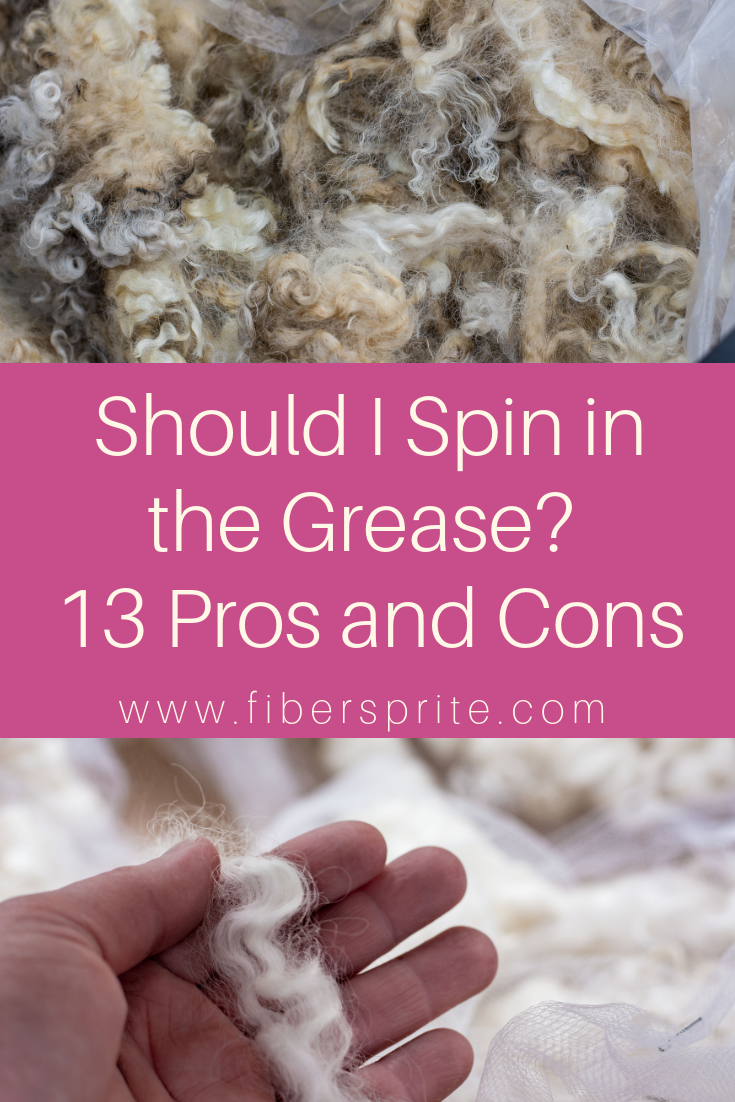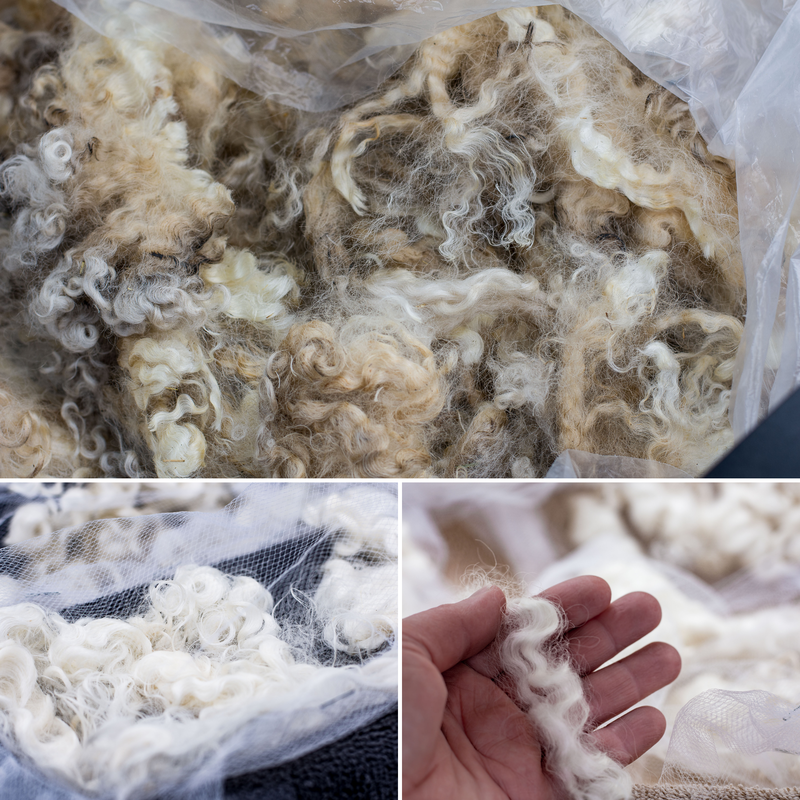|
Have you heard of "spinning in the grease"? It's a term that spinners use to say they are more or less spinning the wool straight off the sheep. The "grease" is lanolin - the natural wax sheep secrete from their sebaceous glands. As a sheep grows its fleece each year, it is also secreting lanolin, just like our skin produces oil. Just like some people have more oily skin and hair than others, some sheep produce more lanolin than others. Lanolin can account for anywhere between 5-25% of the weight of a sheep's freshly shorn fleece. Lanolin helps sheep protect their fleece and skin from sun and moisture. In addition to being useful to the sheep, lanolin has lots of other uses in cosmetics, lotions, and even shoe polish. When it comes to spinning wool, however, there are lots of opinions about spinning in the grease. Some people love it, some people hate it. Some people only spin in the grease, while others only spin with scoured (cleaned) wool. So why would you spin in the grease? Why might you prefer to spin with cleaned wool? This post will walk you through some the pros and cons of spinning in the grease, so when you find a fleece at your next fiber festival, you'll have a better idea of whether you want to scour or spin in the grease. Pros - Spinning in the Grease Here are a few reasons why you might want to spin "in the grease." 1. Your fleece is freshly shorn Spinning in the grease works best when your fleece is freshly shorn. Lanolin hardens over time, making spinning in the grease more difficult. So if you want to spin in the grease, it's best to spin wool that has been shorn recently (usually within the last four to six months). 2. Less time cleaning, more time spinning The biggest reason you might want to spin in the grease is that there's less processing involved. Scouring a fleece is a time-intensive process that also requires lots of water and detergent. When you spin in the grease, you simply remove the really nasty bits from the hind areas (yes, that's POOP!), discard those, and spin the rest. No hauling water, just spin, spin spin. 3. Your fleece is already pretty clean Spinning in the grease works best when your fleece is already very clean. Maybe the sheep wore a coat to protect its fleece (yep, it's a real thing!), or maybe it just lives in an environment where it doesn't get very dirty to begin with. When a fleece is very clean to begin with, less processing is required overall. Processing steps like picking, combing, and carding are therefore not necessary to remove bits of vegetable matter like hay and grass. 4. Your fleece does not have an excessive amount of lanolin Remember how some sheep have more lanolin than others? Spinning in the grease is usually reserved for breeds that have lower amounts of lanolin, rather than breeds that have tons of it. The reason for this is simple - when you're spinning in the grease, the waxes on the wool will be transferring to your hands. A little bit can be nice, but a lot will feel like a sticky mess. Some of this amounts to personal preference. You may want to experiment with raw wool from a few different breeds and see what feels right to you. 4. You want to keep the natural lanolin Lanolin protects sheep's skin from moisture. If you want to retain the semi-waterproof qualities of a sheep's fleece, spinning in the grease is a good way to do that. Or maybe you just love the smell of lanolin. 5. You don't intend to dye the wool before spinning You might feel like your fleece is pretty clean, but even small amounts of dirt and lanolin can prevent wool from taking dye evenly. If you're keeping the natural colors of the wool, this is less of a concern. 6. You're curious! This is as good a reason as any to spin in the grease - at least a few times. Trying this technique can help you learn and grow as a spinner. Safety Precautions for Spinning in the Grease If you do choose to spin in the grease, remember that sheep are barnyard animals doing barnyard things. Raw wool can be a joy to spin, but it can contain things you wouldn't want to eat...like poop. Always wash your hands after handling raw wool. Cons - Spinning in the Grease Although there are plenty of valid reasons to spin in the grease, there are other reasons why you might want to clean your wool first. This step is called "scouring." Pretty much all commercial wool has been scoured to some degree to remove lanolin, dirt, and vegetable matter. 1. Your fleece has been in storage for a while As lanolin ages, it hardens into a stiff wax. This makes spinning difficult at best. While it's possible to soften it back up with a little bit of heat, at this point, most people find it better to go ahead and scour the wool to make it easier to spin. 2. Your fleece is from a high-grease breed Breeds like Merino (and their many relatives) were bred to have high amounts of lanolin, back in the days when fleece was sold by weight before scouring. Sneaky. Buyers soon caught on to the ruse, but the sheep still produce lots and lots of lanolin. High-grease sheep have so much lanolin that spinning in the grease can be a sticky mess. So if your fleece is from a high-grease breed, you'll probably want to scour it first. 3. You plan to comb or card your wool For all its beneficial qualities, lanolin is sticky. If you plan to comb or card your wool, you need to consider your tools, which were probably a significant investment. Especially with handcards and drumcarders, it is difficult, if not impossible to completely remove lanolin from your tools. If you can't clean them completely, they won't last you as long. There are plenty of reasons why you might want to comb or card your wool. Combing and carding wool gives you a lot more control over your spinning process. It helps you to eliminate second cuts that result in lumpy bumpy bits in your yarn, and it gives you an opportunity to remove any sneaky bits of vegetable matter. Besides the longevity of your tools, another reason to scour before combing and carding is that the stickiness of the lanolin may make it more difficult to comb and card. Some spinners report more breakage in their wool when combing and carding raw wool, in part because the lanolin wants to hold everything together. This can be incredibly frustrating during the combing/carding process, and can also lead to the frustration of lumpy/bumpy bits in your spinning fiber. So if you plan to comb or card your wool, plan on scouring it first. 4. Critters love dirty wool Dirty wool is a magnet for critters. Dirty wool, especially wool that contains lots of vegetable matter and leftover bits of food, is a buffet for little animals like mice and MOTHS. If your fleece has lots of vegetable matter, it's better to spend time cleaning it out rather than risk attracting them into your stash. 5. Dust Even a fleece that seems very clean can still hold lots of dust. As you spin, some of this dust will get trapped in the twist of your yarn and will never get completely washed out. Some of the dust will end up on your floor, and some of it will fly into the air and into your lungs. So if you don't like sweeping (like me) or have respiratory issues like asthma, you might want to scour before you spin. 6. POOP I like to say that sheep are barnyard animals who do barnyard things. And yes, this means that they poop. A lot. And as barnyard animals who don't willingly bathe, some of that poop gets stuck in their butts. A well-skirted fleece will have removed most visible bits of poop, but some of it is still in there, even if it's not visible. If this doesn't gross you out (and you're not pregnant, and you wash your hands after every session spinning raw wool), then by all means - spin in the grease. But if you'd rather keep the poop away from your spinning session, you'll want to scour your wool before you spin it. 7. You want to dye your wool As mentioned above, lanolin can interfere with wool's ability to absorb dye evenly. So if you plan to dye your wool before spinning it, scouring is the way to go. Once the wool has been scoured, it will be much easier to dye. Some Closing Thoughts There have been times that I have spun in the grease (usually with very clean, very fresh, and very low-grease fleeces). However, I tend to fall on the side of almost always scouring my fleeces. There's usually a fairly long period of time between when a fleece comes home with me and when it gets spun. I'd rather not risk inviting critters to munch on my fiber stash, so storing clean fleece is usually my priority. When I brought my first fleece home from a fiber festival, I had no idea where to start with scouring, so I thought I might as well spin it in the grease. But eventually I decided to go ahead and scour the wool, and I was amazed at how much dirt came off what I thought was a perfectly clean fleece. The two images at the top of this post show an un-scoured fleece and the same fleece after scouring. This before/after is more than enough for me to choose to scour whenever I can! Do you ever spin in the grease? I'd love to hear your experiences!
Graeme
1/24/2019 03:50:17 am
Thank you for this article, it's very clear and well thought out, as well as entertaining! I do spin in the grease sometimes and it's something I'd like to do more of and will after reading your piece. The main problem is continuous spinning when you're looking out for odd bits of vm etc.! I wonder how much scouring our spinning ancestors did? Comments are closed.
|
Archives
January 2024
Categories
All
This website uses marketing and tracking technologies. Opting out of this will opt you out of all cookies, except for those needed to run the website. Note that some products may not work as well without tracking cookies. Opt Out of Cookies |


 RSS Feed
RSS Feed